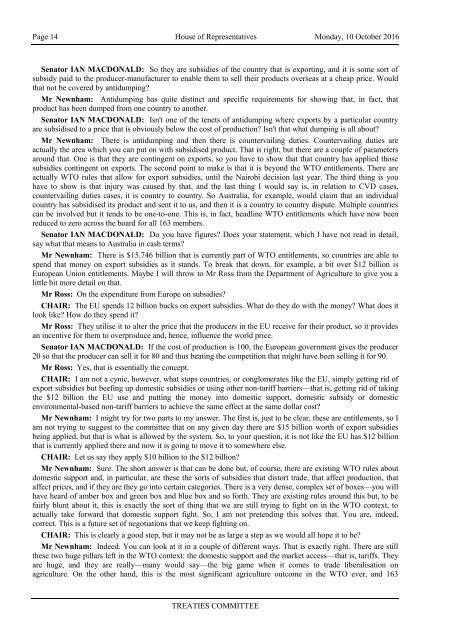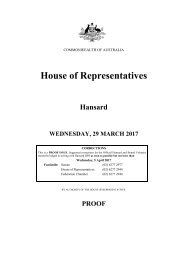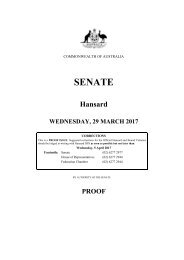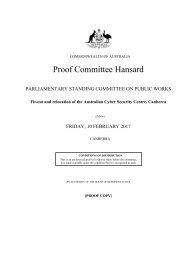Proof Committee Hansard
2d908Ic
2d908Ic
You also want an ePaper? Increase the reach of your titles
YUMPU automatically turns print PDFs into web optimized ePapers that Google loves.
Page 14 House of Representatives Monday, 10 October 2016<br />
Senator IAN MACDONALD: So they are subsidies of the country that is exporting, and it is some sort of<br />
subsidy paid to the producer-manufacturer to enable them to sell their products overseas at a cheap price. Would<br />
that not be covered by antidumping?<br />
Mr Newnham: Antidumping has quite distinct and specific requirements for showing that, in fact, that<br />
product has been dumped from one country to another.<br />
Senator IAN MACDONALD: Isn't one of the tenets of antidumping where exports by a particular country<br />
are subsidised to a price that is obviously below the cost of production? Isn't that what dumping is all about?<br />
Mr Newnham: There is antidumping and then there is countervailing duties. Countervailing duties are<br />
actually the area which you can put on with subsidised product. That is right, but there are a couple of parameters<br />
around that. One is that they are contingent on exports, so you have to show that that country has applied those<br />
subsidies contingent on exports. The second point to make is that it is beyond the WTO entitlements. There are<br />
actually WTO rules that allow for export subsidies, until the Nairobi decision last year. The third thing is you<br />
have to show is that injury was caused by that, and the last thing I would say is, in relation to CVD cases,<br />
countervailing duties cases, it is country to country. So Australia, for example, would claim that an individual<br />
country has subsidised its product and sent it to us, and then it is a country to country dispute. Multiple countries<br />
can be involved but it tends to be one-to-one. This is, in fact, headline WTO entitlements which have now been<br />
reduced to zero across the board for all 163 members.<br />
Senator IAN MACDONALD: Do you have figures? Does your statement, which I have not read in detail,<br />
say what that means to Australia in cash terms?<br />
Mr Newnham: There is $15.746 billion that is currently part of WTO entitlements, so countries are able to<br />
spend that money on export subsidies as it stands. To break that down, for example, a bit over $12 billion is<br />
European Union entitlements. Maybe I will throw to Mr Ross from the Department of Agriculture to give you a<br />
little bit more detail on that.<br />
Mr Ross: On the expenditure from Europe on subsidies?<br />
CHAIR: The EU spends 12 billion bucks on export subsidies. What do they do with the money? What does it<br />
look like? How do they spend it?<br />
Mr Ross: They utilise it to alter the price that the producers in the EU receive for their product, so it provides<br />
an incentive for them to overproduce and, hence, influence the world price.<br />
Senator IAN MACDONALD: If the cost of production is 100, the European government gives the producer<br />
20 so that the producer can sell it for 80 and thus beating the competition that might have been selling it for 90.<br />
Mr Ross: Yes, that is essentially the concept.<br />
CHAIR: I am not a cynic, however, what stops countries, or conglomerates like the EU, simply getting rid of<br />
export subsidies but beefing up domestic subsidies or using other non-tariff barriers—that is, getting rid of taking<br />
the $12 billion the EU use and putting the money into domestic support, domestic subsidy or domestic<br />
environmental-based non-tariff barriers to achieve the same effect at the same dollar cost?<br />
Mr Newnham: I might try for two parts to my answer. The first is, just to be clear, these are entitlements, so I<br />
am not trying to suggest to the committee that on any given day there are $15 billion worth of export subsidies<br />
being applied, but that is what is allowed by the system. So, to your question, it is not like the EU has $12 billion<br />
that is currently applied there and now it is going to move it to somewhere else.<br />
CHAIR: Let us say they apply $10 billion to the $12 billion?<br />
Mr Newnham: Sure. The short answer is that can be done but, of course, there are existing WTO rules about<br />
domestic support and, in particular, are these the sorts of subsidies that distort trade, that affect production, that<br />
affect prices, and if they are they go into certain categories. There is a very dense, complex set of boxes—you will<br />
have heard of amber box and green box and blue box and so forth. They are existing rules around this but, to be<br />
fairly blunt about it, this is exactly the sort of thing that we are still trying to fight on in the WTO context, to<br />
actually take forward that domestic support fight. So, I am not pretending this solves that. You are, indeed,<br />
correct. This is a future set of negotiations that we keep fighting on.<br />
CHAIR: This is clearly a good step, but it may not be as large a step as we would all hope it to be?<br />
Mr Newnham: Indeed. You can look at it in a couple of different ways. That is exactly right. There are still<br />
these two huge pillars left in the WTO context: the domestic support and the market access—that is, tariffs. They<br />
are huge, and they are really—many would say—the big game when it comes to trade liberalisation on<br />
agriculture. On the other hand, this is the most significant agriculture outcome in the WTO ever, and 163<br />
TREATIES COMMITTEE















